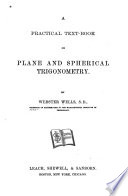 | Webster Wells - 1883 - 298 pages
...following elementary properties of spherical triangles may be found in any treatise on Solid Geometry : (a) . Any side of a spherical triangle is less than the sum of the other two. (6). If two sides of a spherical triangle are equal, the angles opposite them are equal ; and conversely.... | |
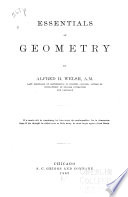 | Alfred Hix Welsh - Geometry - 1883 - 326 pages
...will be respectively equal to the sum of two of the partial triangles minus the third. THEOREM XV. Any side of a spherical triangle is less than the sum of the other two, and greater than their difference. Let ABC be any spherical triangle on the sphere whose centre is... | |
 | Evan Wilhelm Evans - Geometry - 1884 - 242 pages
...sphere. Its planes cut the surface in arcs of great circles, which form a spherical triangle. Cor. 1. — Any side of a spherical triangle is less than the sum of the other two (?). Cor. 2. — The perimeter of a spherical triangle is less than a great circle (?). 9. To find... | |
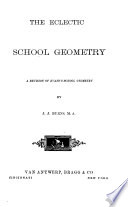 | Evan Wilhelm Evans - Geometry - 1884 - 170 pages
...Its planes cut the surface in arcs of great circles, which form a spherical triangle. Cor. 1.—Any side of a spherical triangle is less than the sum of the other two(?). 9. To find the surface of a material sphere. Suppose that the given sphere be of wood or iron. Let... | |
 | Charles Davies, Adrien Marie Legendre - Geometry - 1885 - 538 pages
...great circle joining the vertices of any two angles which are not consecutive. PROPOSITION I. THEOREM. side of a spherical triangle is less than the sum of the two others. Let ABC be a spherical triangle situated on a sphere whose centre is O: then is any side,... | |
 | William Chauvenet, William Elwood Byerly - Geometry - 1887 - 331 pages
...angles of a spherical triangle are equal, the triangle is isosceles. PROPOSITION XVI.—THEOREM. 61. Any side of a spherical triangle is less than the sum of the other two. Let ABC be a spherical triangle; then any side, as AC, is less than the sum of the other two, AB and... | |
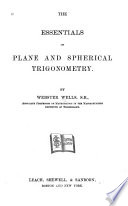 | Webster Wells - Trigonometry - 1887 - 200 pages
...following properties of spherical triangles may be found in any treatise on Solid Geometry : (a) Either side of a spherical triangle is less than the sum of the other two sides. (b) If two sides of a spherical triangle are unequal, the angles opposite them are unequal, and the... | |
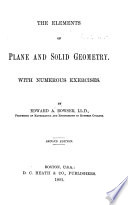 | Edward Albert Bowser - Geometry - 1890 - 420 pages
...Uie same relation between the face, and diedral, angles of a polyedral angle. Therefore: 704. Each side of a spherical triangle is less than the sum of the other two sides (565). 705. The sum of the sides of a spherical polygon is less than a circumference (566). 706. Two... | |
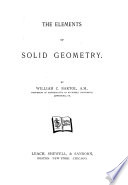 | William C. Bartol - Geometry, Solid - 1893 - 112 pages
...mutually equilateral, their polar triangles are mutually equiangular. PROPOSITION XXXIII. 209. THEOREM. Any side of a spherical triangle is less than the sum of the other two sides. In the spherical triangle ABC let the side BC be greater than either AC or AB; then will BC be less... | |
 | William Chauvenet - 1893 - 340 pages
...angles of a spherical triangle are equal, the triangle is isosceles. PROPOSITION XVI.—THEOREM. 61. Any side of a spherical triangle is less than the sum of the other two. Let ABC be a spherical triangle; then any side, as AC, is less than the sum of the other two, AB and... | |
| |